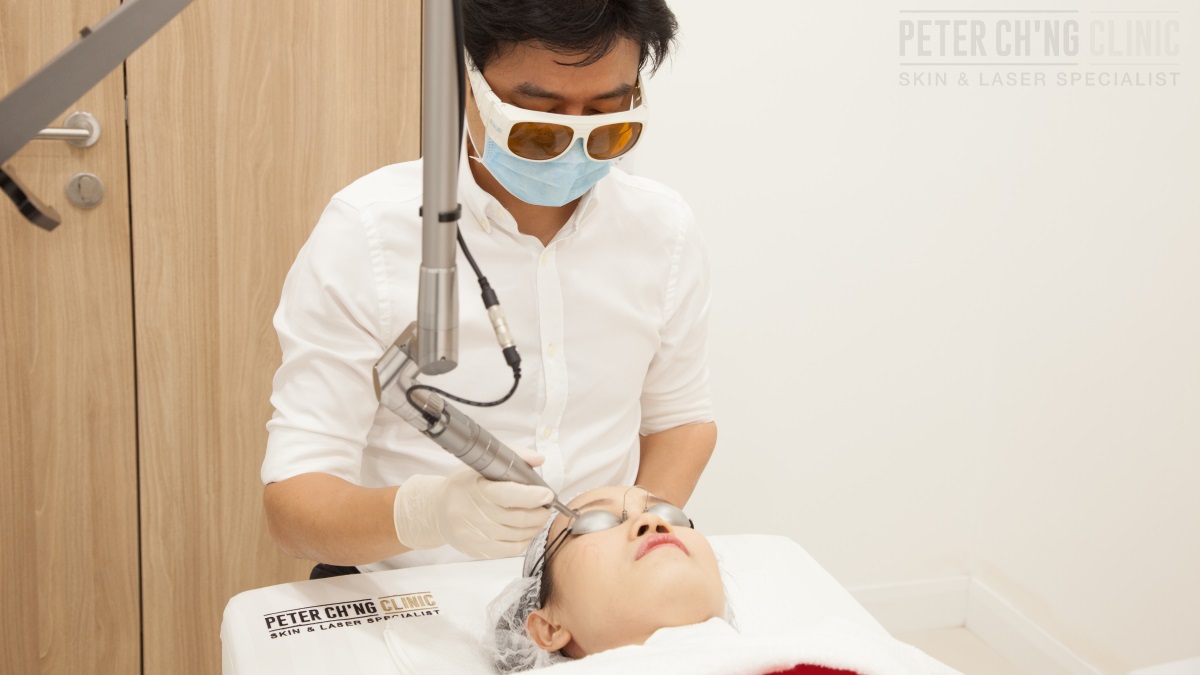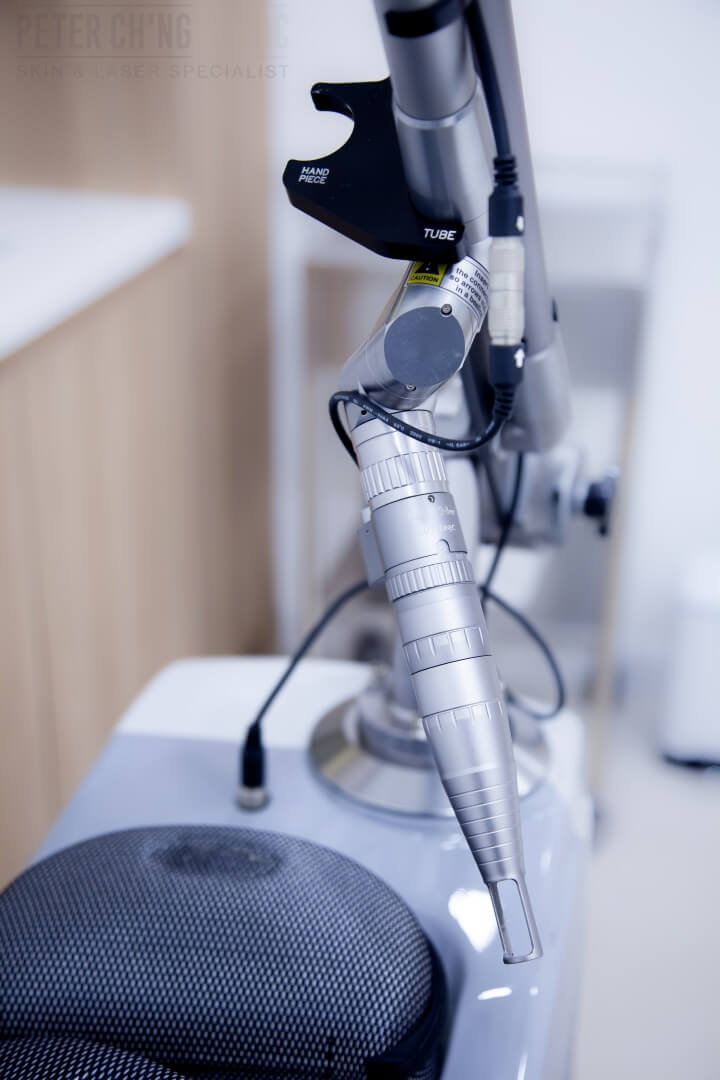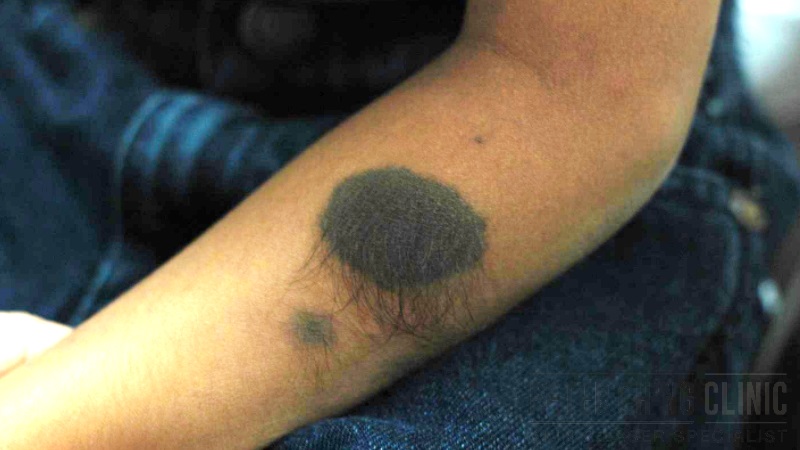Pigment Laser

What is a pigment laser?

Laser treatments are always one of the most effective treatments to get rid of pigmentation on the skin.
Pigment lasers can penetrate deep into the skin and remove the pigments beneath the skin to make the spots on the skin surface disappear.
How we do pigment lasers

During a laser treatment, the laser peels off the pigments on the skin. This forms a thin crust on the skin of the treatment area after every treatment due to the peeling off of the freckle pigments.
After a few weeks, these crusts peel off on their own, leaving your skin pigmentation-free.
Pigment lasers can also remove tattoos, moles, or birthmarks.
Dr Loo and Dr Peter will thoroughly analyze your mole and birthmark to decide which treatment method is the most suitable for your condition, and also check if there are any underlying conditions behind the formation of these skin conditions, because safety and effectiveness is always the top priority.
The laser treatment itself doesn't take long, but several treatments may be needed for complete removal.
On the other hand, using a laser treatment, the tattoo ink and pigments with the tattoo will absorb the laser light.
With a laser tattoo removal treatment, we usually need several sessions to remove the tattoo completely, and each session is done one month apart with repeated procedures.
During the treatment, there may be some discomfort, but a numbing cream is used to reduce the discomfort prior to the treatment.
The tattoo will not disappear instantly after the laser treatment. In fact, after the laser treatment, the tattoo may become even darker in colour, and there may be a margin of redness surrounding the tattoo.
Then over the next couple of weeks, we can see the tattoo starting to lighten and slowly fade.
What to watch out for

If used by a skilled doctor, the laser can be adjusted to the best and most accurate position to target all the pigments accurately so that the results are precise and satisfactory.
Knowing the skin type of the patients is also important, so that doctors know what laser to use, and what level of laser energy to be used for different skin types.
During the treatment, doctors also need to clearly know the endpoint of the procedure being carried out, to know whether to increase or decrease the laser energy throughout the treatment process.
This is why you should always only get your aesthetic treatments from certified medical doctors and professionals. Getting a laser treatment from unqualified practitioners can expose you to risks of complications you don't want on your skin and body!
Both Dr Peter Ch’ng and Dr Loo are experts and specialists in skin and aesthetics, and they pride themselves in their skills and care for the patients in carrying out procedures and treatments here at Peter Ch’ng Clinic. So you need not worry when it comes to treatment precision, effectiveness, and safety when getting a laser treatment for your skin here.
There are different types of pigmentation. Which do you have?
1. Freckles (Ephelides)
What: Small, flat brown spots which develop on sun exposed areas like the face. Fair people are more prone to freckles. They appear darker in the summer and lighter in the winter as the skin produces more pigments (melanin) under the sun.
How: Sun exposure, genetics
2. Sun spots/liver spots (Lentigenes)
What: Pigmented spots with a clearly defined edge, larger than freckles. They occur anywhere on the body, particularly the back of the hands and the face, due to sun exposure. Lentigines increase in number with age, making them common among the older population. These spots need to be monitored as they may develop into skin cancer.
How: Sun exposure
3. Melasma
What: Large, brown or gray patches on the face, forearm or neck with a non distinctive border. This kind of pigmentation is deeper down in the skin's dermis. More commonly affects women.
How: Sun exposure, hormonal changes, pregnancy, age, changes in hormones
4. Post-inflammatory hyperpigmentation
What: Skin pigmentation which occurs due to skin injury such as eczema, burns, acne, friction, etc. Usually heals by itself over time and can be treated with topical creams or lasers.
How: Skin injury
5. Hori's Nevus
What: Symmetrical grey-brown or blue-grey spots which appear most commonly on the cheek. Sometimes may develop on the forehead, nose, eyelids and temples. This kind of pigmentation is deeper down in the skin's dermis.
How: Genetics, hormones
6. Nevus of Ota
What: Blue pigmentation which occurs on the face. Most cases involve the sclera (whites of the eye) and less commonly, the cheek, face, nose, forehead and around the eye. Occurs more commonly in women.
How: Occurs at birth or at puberty
7. Skin cancer (Malignant melanoma)
What: The most dangerous type of skin cancer which develops in the melanocytes (cells which give the skin colour) and has a high chance of spreading. May be treated by surgical removal if it has not spread.
How: Excessive sun exposure, genetics
To enquire more about Pigment Laser, contact us or book an appointment here!
This treatment can treat the following conditions:
Pigmentation, Age Spots, Melasma
There are different types of pigmentation that can form on our skin, including age spots and melasma. These are usually caused by one big culprit - UV rays from excessive sunlight exposure. However, with the right treatment, pigmentation on the skin can be treated.

Moles, Birthmarks and Tattoo
Not all birthmarks and moles are formed at birth. Some develop them at birth, and others develop them only later in life. Effective treatment options depend on the type of birhtmarks and moles present on your skin. Tattoo inks are inked into the middle layer of our skin. So any DIY methods to remove the tattoo wouldn't be effective and may cause scarring. The safest and most effecive solution is a proper medical procedure.
Related treatments and services:

Chemical Peel
Chemical peels are acids that are applied on the skin to cause the skin to peel. This process stimulates the skin cells to regenerate faster and thus fastening the process of skin healing.

Laser Treatments for Moles, Birthmarks & Tattoo
Moles, birthmarks and tattoos all require treatment at the inner layer of our skin. For these conditions, laser treatments are usually the safest and most effective options for removal.
